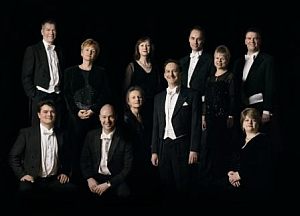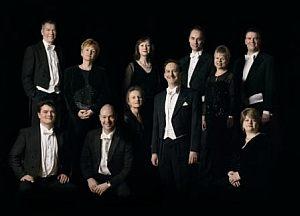I hope British conductor Peter Phillips and members of the Tallis Scholars — the choral ensemble he founded in 1973 — would be flattered to know that one of their recordings was the second compact disc I ever bought. I missed the LP generation, and that CD had been out for 10 years. Sunday’s all-Victoria program presented by Cal Performances at Berkeley’s acoustically ideal First Congregational Church was, therefore, comfort music for me. The performance was as vocally resplendent as my nerdy teenage ears remembered, minus the puffy sleeves and pastels of mid–’80s fashion.

Related Articles
Tallis Scholars’ Telltale Sounds
December 4, 2009
Voices Lifted, in Stereo
March 28, 2009
By “Victoria,” I mean Spanish composer Tomás Luis de Victoria (1548–1611), a composer who holds his place in music history due, in part, to musical quality and craftsmanship but also, in part, to historical circumstance. The composer came of age during a time of great reform in the Roman Catholic Church, called the Counter-Reformation, which culminated in the 1545–1563 Council of Trent. The council standardized the Catholic Mass; thereafter, it remained essentially unchanged until the second Vatican Council of the 1960s. Older music poorly fit the new Mass, so churches in Catholic countries demanded new music — a demand met by advances in music printing. The Italian-trained Victoria rose to a place of musical prominence in the staunchly Catholic Spanish court, which was also one of the richest and most prominent, after its American conquests. From his high post, Victoria published 11 collections of music in his lifetime; his works, alongside those of Palestrina and Lassus, were church repertory staples for centuries to come.
The Tallis Scholars harnessed the power of deathdays (let’s celebrate!) to present two smart programs titled “The Victoria Project,” of which Sunday’s, “Victoria’s Greatest Hits,” was the second. A better term would have been “A Victoria Spectacular.” With works sung from 60-year-old editions by a composer continuously in the repertory of British cathedral choirs since the 19th century, the concert had little of the ambition I ascribe to the term project. The program’s centerpiece, a compilation of music written for a 1603 VIP funeral and later published together as Officium Defunctorum (music for the Offices; i.e., Mass, for the dead), was retitled Requiem, — a term that Victoria and his contemporaries never used except when capitalizing on the titles of popular 19th-century choral/orchestral works.
In terms of musical interest, Victoria’s music sustains a full concert much better than does Palestrina’s. The Tallis Scholars sang the responses (shorter pieces sung in between readings in a Mass) “Dum complerentur” and “Quem vidistis, pastores?” in their entirety. Renaissance works frequently are divided into two parts, and choirs today, especially in church services, often sing only one half or the other. In “Quem vidistis,” each part ends with exuberant alleluias, each clearly relating to the other half. Victoria’s consistent attention to crafting alleluias makes their absence felt in unhappy works such as “Tenebrae” responses.
Typically British
As few Bay Area choirs are capable of reaching the same high standard of performance without charging Cal Performance’s hefty $52 per ticket, I found it worthwhile to concentrate on aspects of the performance I consider characteristically British. Musicians — both singers and orchestral players — at conservatories in Commonwealth nations are taught to become good ensemble players, rather than soloists. At the professional level, great pride is taken in minimizing rehearsal time. This is part of the reason film music is often recorded in London, in spite of the city’s high cost of living.
In Berkeley, the solo trios in Victoria’s “Animam meam dilectam” showed how individual Tallis singers adopted a tone appropriate to choral singing but one that sounds peculiar when exposed. Many commentators focus on the typical lack of vibrato in early-music singing. I dislike this, because it defines singing in the negative: by what it’s not. The Tallis Scholars’ basses and tenors actually used quite a bit of vibrato, but it was of the thin-pressed variety I commonly hear in English singers.
The salient feature of the Tallis Scholars’ singing, which is done in a distinctly modern style that is well-suited to digital recording, is clarity. Multiple interlocking melodies — polyphony — are the essence of Renaissance music, and successful performance depends on delineation of these melodies. Vibrato, especially in higher notes, obscures the musical lines; therefore, it does not come under consideration. Most important is perfection in tuning, sensitivity of line, and overall blend and balance of voices. Victoria, who was a Catholic priest, certainly did not envision his music being sung by a mixed-voice choir such as the five women and five men of the Tallis Scholars, since asking women to remove their mantillas, open their mouths, and learn how to read (all in the presence of men) was quite unacceptable in church.
Director Peter Phillips, who takes pride on his lack of training, appeared much less spasmodic than I have seen him in the past. His conducting has earned a reputation for being jerky, and singers have to learn to ignore or reinterpret some eccentricities that can interfere with attempts to breathe. He clearly understands this music, though, and enforced interpretations that were both strong-willed and well-balanced.

